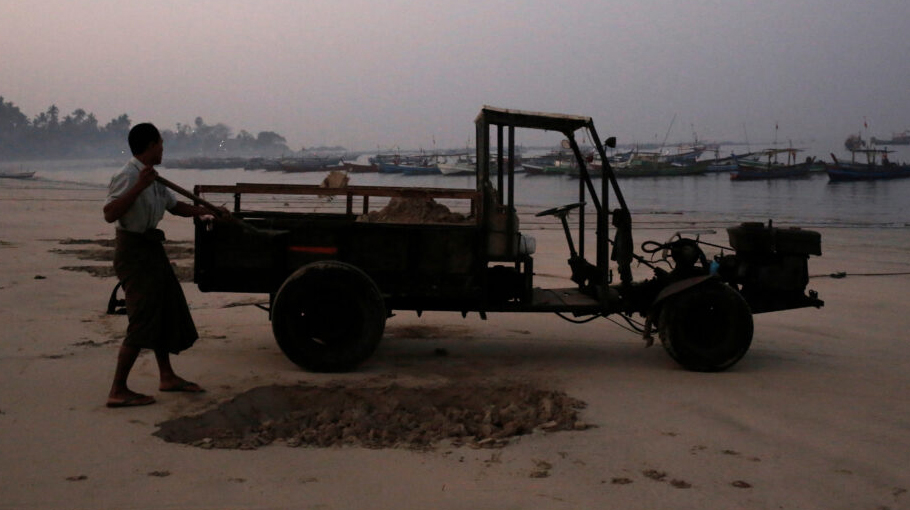Post-coup environmental degradation threatens Myanmar’s stability

Myanmar’s 2021 military coup has given rise to significant uncertainty regarding the stability of the country. The seizure of power by the military has sparked armed resistance and an overall deterioration in the country’s economic conditions. In response to international sanctions, the junta has been compelled to rely on its natural resource reserves to fund its military expenditure.
The previous government, which enjoyed significant public support, imposed a nationwide logging ban in 2016 and extended it for a decade in the densely forested Pegu Yoma region. But following the military coup, illegal logging activities have been booming. According to satellite data, extensive areas of the central rainforest have been chopped down, with this deforestation linked to the junta.
As law and order has deteriorated, there has been a surge in illegal mining activities in the country’s remote areas. Local activist groups have accused the military junta of backing these unlawful mining operations. Mining for rare earth elements, which is flourishing in Myanmar’s northern Kachin mountain zone, has devastating and unpredictable consequences for the region’s ecosystem and inhabitants.
Climate change is also significantly impacting Myanmar. In 2010, Myanmar encountered droughts as the region witnessed record-breaking temperatures, with numerous areas recording an average temperature increase of two to three degrees Celsius. In 1997, 1998, 2010 and 2014, the central regions of Mandalay, Magway and Sagaing experienced crop failures due to droughts. These regions, with a combined population of 11 million, rely heavily on agriculture, contributing about 22 per cent of Myanmar’s rice paddy, 89 per cent of its sesame production and substantial quantities of pulses, seeds and livestock.
Following the military coup, rare earth mining has experienced a boom in Myanmar’s north-eastern region. The region is under the control of a Border Guard Force that falls under the military’s chain of command. There are approximately 2700 rare earth mining collection pools scattered across nearly 300 locations, covering an area roughly the size of Singapore.
The mining method employed in Myanmar, known as in-situ leaching, involves removing vegetation and drilling holes into the mountains, followed by injecting a solution of ammonium sulphate into the holes to dissolve the rare earth ions from the rock. The resulting liquid is then drained into collection pools, where the rare earth minerals are precipitated. But after the leaching process, the chemical-filled pools are abandoned without any rehabilitation efforts.
The effects of rare earth mining on local communities are long-lasting, resulting in significant environmental damage that requires billions of dollars in clean-up costs. In China’s Jiangxi province, where many rare earth mines have closed, the environmental clean-up costs amounted to US$5.5 billion and recovery is expected to take up to 100 years.
Global Witness’s 2022 Myanmar report highlights the dire situation, noting that rivers remain contaminated and that this has led to the disappearance of most fish, birds and other animals.
Local communities continue to struggle to access clean drinking water and farmers are unable to grow crops near the mining areas. A critical concern is that contaminated watercourses near the mines flow directly into the N’Mai River, a tributary of the Irrawaddy River, which supports two-thirds of the country’s population.
Urgent action is needed to address the military junta and other armed organisations’ involvement in risky natural resource ventures, particularly rare earth mining, which has severe consequences for Myanmar’s environment and the nation as a whole. But at a time when Myanmar’s environment desperately requires defenders, environmental activists are encountering new pressures and security threats. The safety of activists has become more precarious due to the highly restrictive Organisation Registration Law enacted in October 2022. The junta has already detained several environmental activists.
The junta’s approach to natural disaster management has also put thousands of lives at risk. The junta at times views international aid as a threat to its power and has blocked such assistance. During the 2008 Cyclone Nargis, the former military regime deliberately hindered international aid to cyclone victims. A decade later, 2023’s Cyclone Mocha brought torrential rain and devastating winds that wreaked havoc on large parts of Myanmar’s coastline. Once again, the junta demonstrated its resistance to humanitarian access, particularly in Rakhine State.
Environmental degradation, natural disaster mismanagement and climate change in Myanmar are not just local issues, but also affect neighbouring countries. Due to the political turmoil, Myanmar is home to 1.7 million internally displaced people. Climate change could fuel a further collapse of the state economy and send millions of climate change refugees to neighbouring countries. Western sanctions on Myanmar may not be effective in addressing this issue since the primary consumer of Myanmar’s rare earth minerals is China. But consumers of Chinese batteries should be made aware of sustainability and ethical issues in these supply chains.
Addressing the climate crisis in Myanmar requires targeted international sanctions on the junta’s high-risk resource businesses. Engaging with democratic groups in Myanmar, such as the National Unity Government and ethnic armed organisations with environmental policies, could help mitigate the environmental and climate challenges the country is facing.
The international community must recognise that these issues not only affect Myanmar but also have regional implications.
Urgent action is needed to protect Myanmar’s environment, economy and population.
Htet Myat Aung is an
independent researcher and activist on Myanmar’s democracy and environmental issues. He is a former peace ambassador of the Institute for Economics and Peace.




